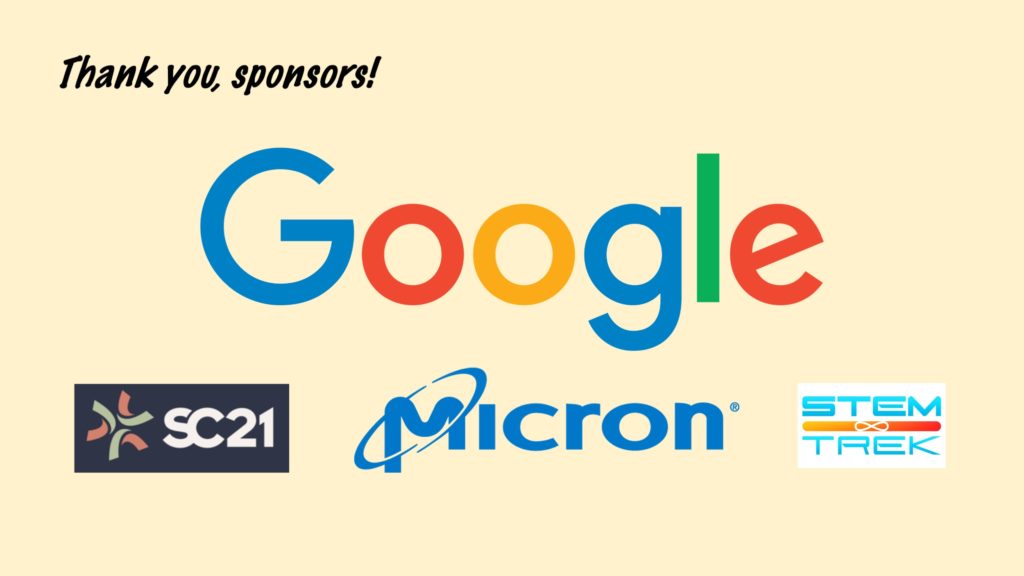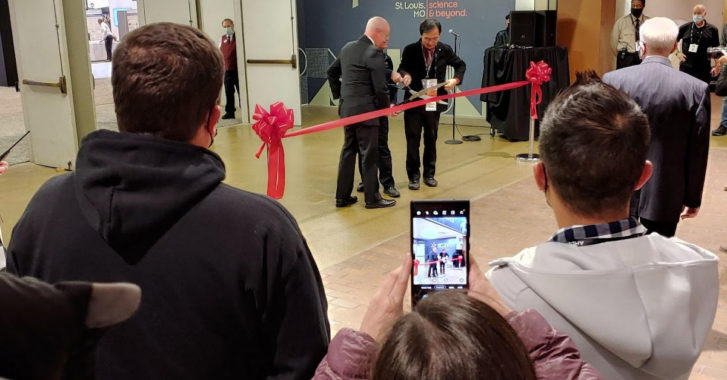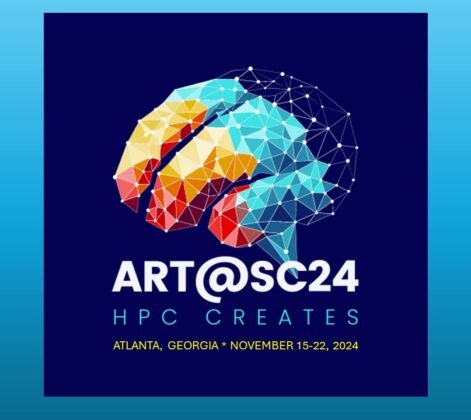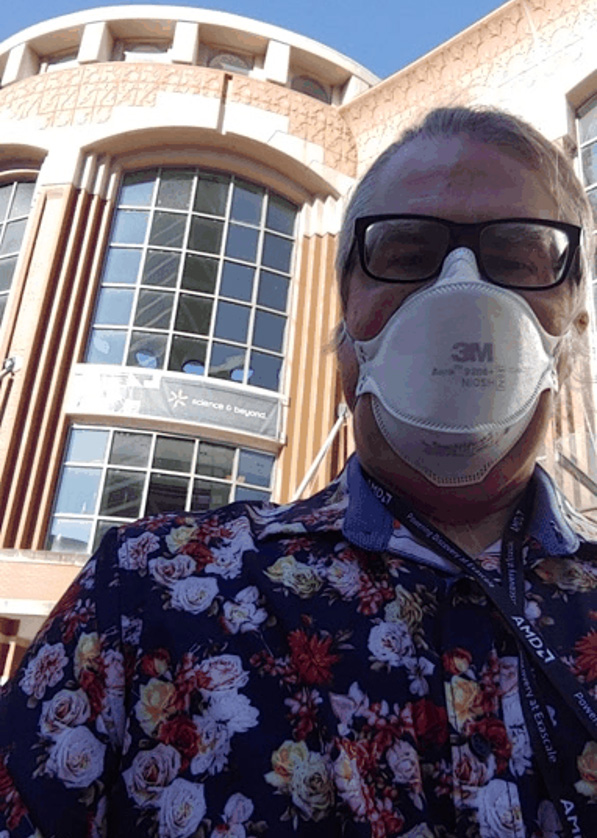
Attending the first pandemic in-person SC was not without its concerns (and I say pandemic because this thing is not over). But with a vaccination requirement and a mask mandate, attendance safety protocols were stricter than at my workplace. I wondered how the conference would proceed in a hybrid format with substantially reduced in-person attendance compared to previous years. As a Missourian, there was frustration that we finally got SC in St. Louis, but in circumstances that made in-person attendance difficult for some.
St. Louis is only a two-hour drive for me, I have a stash of N95 masks and a year of experience navigating the pandemic in a classroom environment. Assistance from STEM-Trek removed whatever lingering doubts I might have had about attending. So I showed up at the St. Louis America’s Center, adorned in a 3M N95 Aura face mask (much better than the cup N95s, since these flex with your face as you talk), and a loud, floral print shirt to bring some energy to what I expected to be a subdued proceeding.
My expectations were exceeded. The organizing committee did a fantastic job bringing back the in-person conference in a hybrid format. I noticed early in the conference that the prelude music for the plenary and keynotes was Dave Brubeck jazz, rather than the rhythmic, driving music I am accustomed to. This seemed to capture the early mood of the conference—mellow, rather than subdued. Later in the week, the music changed to a poppier style which seemed to capture the arc of attendees adjusting to the hybrid format. As I joined the hordes at the SC22 booth to get my tee-shirt and listened to hopeful plans for attending SC22 (Dallas) next year, it felt like SC21 ended with more energy than it started.
Tutorials/Workshops
I can’t match the exemplary reporting on SC21 by HPCWire, but I will offer my brief perspective on the sessions I attended. I arrived Sunday at the America’s Center in a bit of a rush to get registered. I thought I had my Clear app completely set up, but I still needed a picture which added a bit of a delay, but once I had my badge there were no problems (a bit of an inconvenience? Not compared to a serious infection. I definitely appreciated the concern for attendee safety).
I had intended to attend the networking tutorials that day, but I arrived late for the first one. Upon checking my options, I realized the EduHPC workshop started soon. Heck, I’m a member of EduHPC, I pay my annual $10 fee, so I should be at that workshop! Which worked out well. The opening talk by Sandy Landsberg (Director of the Mathematics, Computer and Information Sciences Division in the Information, Cyber and Spectrum Superiority Department of the Office of Naval Research) explained applications for HPC at the U.S. Departments of Energy and Defense (DOE/DOD) and student funding opportunities. While I am aware of the DOE and DOD as funding sources, my natural instinct is to look to NSF. At the exhibition, I dropped by the DOE booth to pick up literature on student opportunities. Landsberg made a comment that especially resonated – training in HPC and computation, in general, is in the national interest. This aligns with my advocacy at my university. I believe that some computational coursework should be part of every 21st-century curriculum (CS101 as a gen-ed requirement, for example).
I then attended the “Designing HPC Systems with High-Performance Networks” tutorial. Participating in a recent grant proposal made me realize how little I know about networking. ACM-IEEE Ken Kennedy Award-winner David Abramson (U-Queensland) in his acceptance speech talked about bringing high school students to SC and throwing them into the deep end. I am certainly not averse to that, that’s how you start to learn. But I must confess that after a few hours of marinating my brain in acronyms, I was ready to tap out. Could we keep high school students engaged?
I attended the “Using Containers to Accelerate HPC” tutorial on Monday, where I became so engrossed in the online exercises that I accidentally worked ahead of the class. At home, I have had some resistance from users when I have suggested containers for the projects they have developed — “It just adds another layer”-so it’s useful to see how they can accelerate HPC. Many of the tutorials and workshops were online, and the organizers had set aside rooms so that in-person attendees could participate in the online sessions. I forgot to bring headphones, so I was stuck with in-person sessions. The hybrid format is probably here to stay, so plan accordingly for next year.
Technical Program
The kickoff plenary in the Ferrara Theater provided a welcome change from previous SC21 plenaries. This was in an actual theater with mid and upper-level tiers! I loved the birds-eye view from the highest tier – no more craning to see over the heads of people in front of me!
Seating in the theater was set up for social distancing:
The plenary panel “The Intersection of Ethics and HPC” got into (what some might consider) controversial territory early on as panelist Tony Hey from the University of Southampton explained the history and ethical issues surrounding the Manhattan Project and atomic bombings of Hiroshima and Nagasaki (at the time, 75 percent of scientists at Los Alamos favored a demonstration in an uninhabited area) based, in part, on his personal knowledge of some of the figures involved. This framed a later discussion about ethics and HPC with the notion that you can’t put things back in the bottle once they are out, be they nuclear weapons or artificial intelligence (AI). This theme was revisited by a couple of other presenters.
The keynote address by Google Internet Evangelist Vint Cerf on “Computing and the Humanities” was spellbinding. His talk was over, the Q&A was over, Vint was leaving the stage, but the audience remained seated until encouraged to leave.
I do first mention the otherworldly conference graphics before the talk:
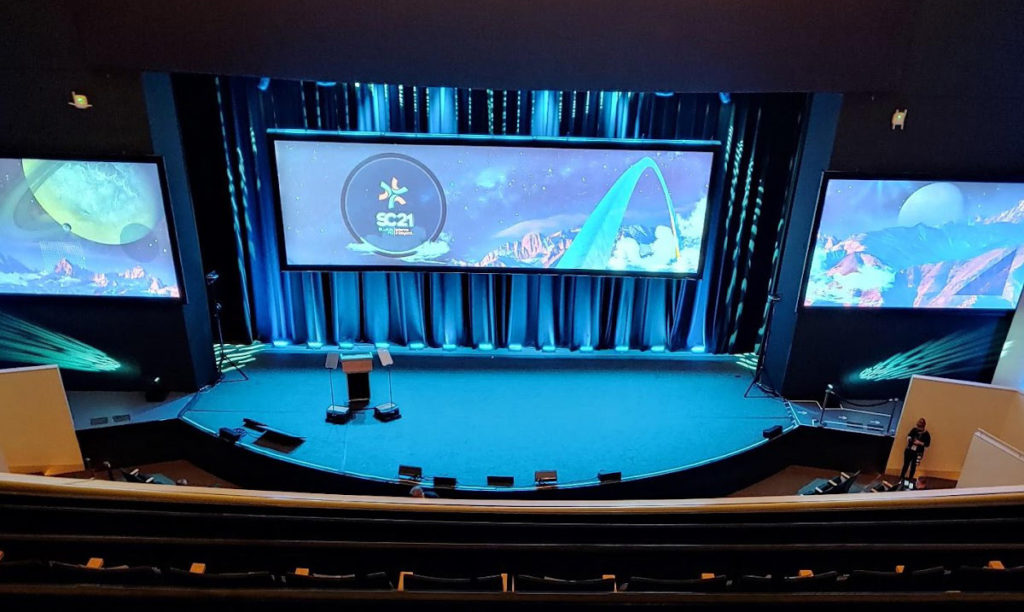
During the talk, I continued to enjoy that top-tier bird’s eye view.
Toward the end of his talk, Vint discussed dangers posed by technology and overreliance on technology (tying back, in a sense, to HPC and Ethics from the panel discussion). He introduced us to the E. M. Forster short story “The Machine Stops,” which made it onto everybody’s reading lists, and his frustrating interactions with a chatbot (at this point the classic “HAL, open the pod bay doors please” kept running through my head). Despite the risks that technology poses, he reiterated during the Q&A how useful technology has been to humanity, most recently in terms of vaccine development.
AI was clearly an underlying theme throughout the conference. Thursday’s invited talk by Kim Hazelwood of Meta/Facebook, “The Growth of AI: Implications on Hardware, Systems, Software, and the Environment” covered the challenges of AI monitoring social media content where context is key (The comment “I love your skin” paired with a picture of a crocodile could be judged as malicious, while the individual items alone are innocent). An order of magnitude increase in parameter and data set sizes were cited as challenges. But quite a bit of the talk focused on the impact of HPC and AI on the environment and sustainability (tying again back to the Plenary panel). This includes the burden not only due to the operation of HPC facilities, but the “inherited” cost that arises from the manufacture of equipment. The audience was introduced to “Jevon’s Paradox.”

Jevon’s Paradox concludes that efficiency must also be balanced with a critical examination of the need for a particular computation to be run. I must note that this was a remotely delivered talk, hence no speaker on the stage. I had totally forgotten until I checked my pictures. It became natural after a while).
The biggest shocker for me at the conference was to learn how much AI/ML was being used in computational chemistry. In Thursday’s invited talk “AI4Science,” Anima Anandkumar (Director of ML research at NVIDIA and Bren Professor at Caltech) kept referring to slower, more traditional DFT methods compared to faster AI methods for computational chemistry. This made me feel ancient because I was already old when DFT was the hot, new, faster method. OrbNet. I need to learn more. The talk by the #CovidIsAirborne group employed similar methods to visualize a virus particle in a respiratory droplet to provide atomic-level views (spike protein on Delta variant opens much more widely than in the wild type, and study of changes in viral particle on pH as droplets evaporate). This talk was prerecorded with multiple authors. They effectively broke up the talk while holding the attention of the audience—an example of how remote presentations can work effectively at in-person conferences.
Wednesday’s talk, “Enabling Large-Scale Correlated Electronic Structure Calculations: Scaling the RI-MP2 Method on Summit”, explored more traditional ab initio methods scaling them up to deal with larger (“exascale”) problems. This left me with a lot of questions. The language surrounding OrbNet “training” of large sets of compounds mimics the language of semi-empirical methods. Traditionally, semi-empirical methods are well suited to interpolating electronic structure for molecules similar to those in the training set whereas ab initio methods are better at extrapolation. Does this hold true for AI vs. ab initio? A comment I heard at a conference a few years ago was that wave function methods are not suitable for extremely large systems (fully expanded Salter determinant has more terms than atoms in the universe). Is AI ultimately the way around this? I left the conference with a bunch of new questions to investigate.
And this does not even get to the MD talks where systems approach the micron scale with trillions of atoms (I was impressed at SC16 with an MD simulation of water with 1.5M atoms!). And the many other takeaways from different talks. With “Science and beyond” as the theme, there was a lot here for a scientist. But I am starting to ramble, so last of all, the…
Exhibition
The exhibition was dramatically smaller in scope than previous years but was well attended. The opening was met with excitement by the assembled crowd:
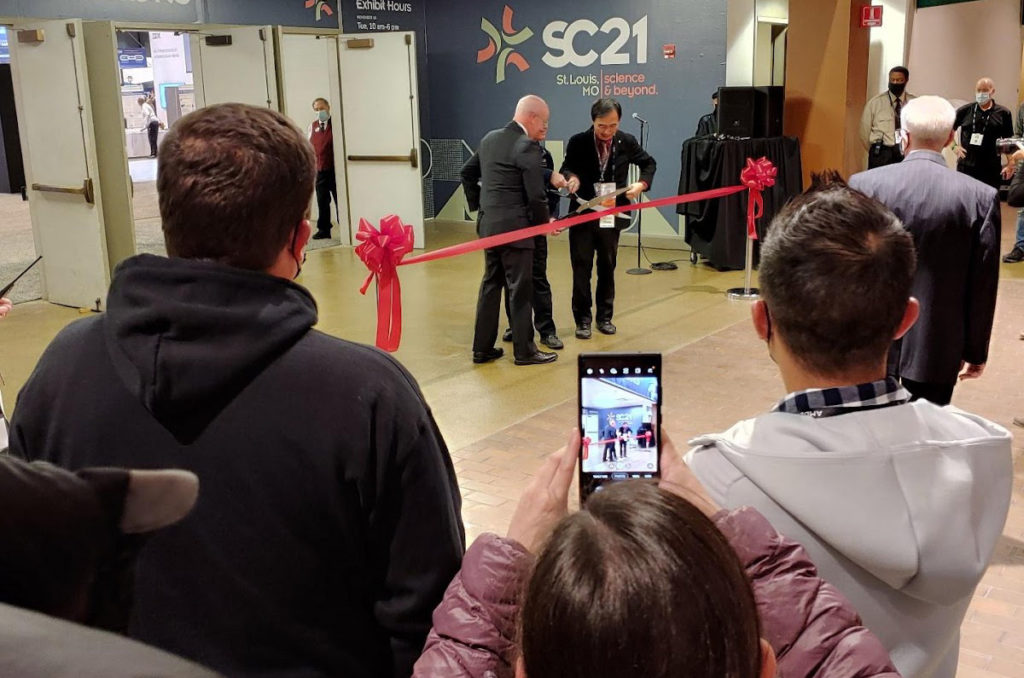
I have always been fascinated with cooling technologies displayed at such exhibitions. I had several interesting conversations with cooling vendors, and it finally occurred to me on the last day of the exhibition that this might be something good to blog about. But there were more vendors than I realized, and the bigger booths were still quite active. So I am transitioning this to a “smaller vendor shoutout” to feature some of the smaller booths I visited.
My most interesting conversation was at the Mikros booth. This company got its start developing cooling for the International Space Station, and they had plenty of shiny objects on display. The flat panels in the device below I initially thought were solid copper that cooled by conduction alone.
There are actually microchannels in the plates for circulating fluid to provide convective heat transfer. The small device below is capable of 1 KW of heat transfer.
I enjoyed this custom-built solution, with fluid going through a dissipative plate, since I went to a talk on the Anton 3 system, and it was cool to see the connection on the floor.
Nitta is a vendor of chemically-inert tubing for cooling systems. Rubber tubing, in particular, has chemicals that can leach out, perhaps pollute the environment (over the long term gum up the system too, I would think). They were quite enthusiastic about their products.
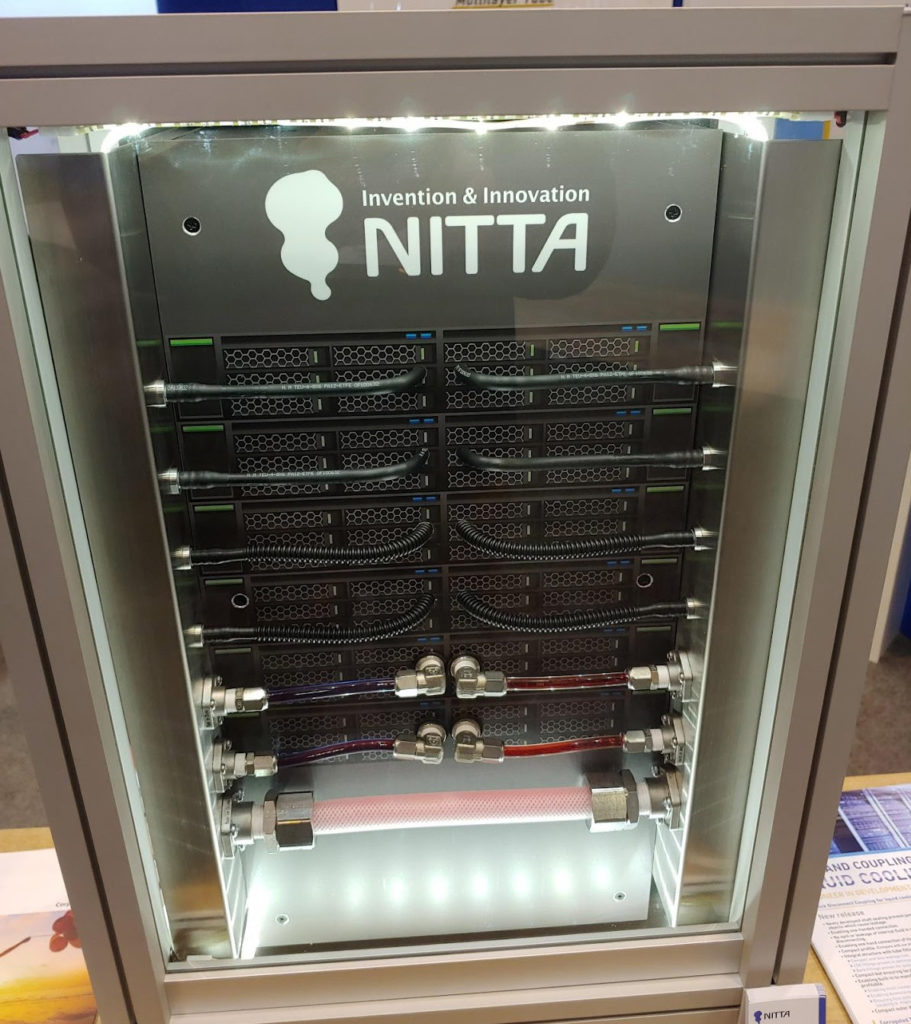
I always enjoy selecting a book when I’m at SC. SIAM was the lone publisher present at SC21, with an array of interesting titles. I chose “Introduction to High Performance Scientific Computing” by David L. Chopp; someday I hope to teach that class.
Last of all, I must mention the University of Missouri booth which represented the host state. They were set up to allow guests to play classic video games (such as Duck Hunt) and featured literature about statewide efforts like the ShowMe Cyberinfrastructure consortium.
At one of the last raffles, as the exhibition wound down, the booth impresario leading the raffle said, to the cheers from the assembled crowd, “Did you miss us? Well, we missed being here. This is always a really fun conference!”
